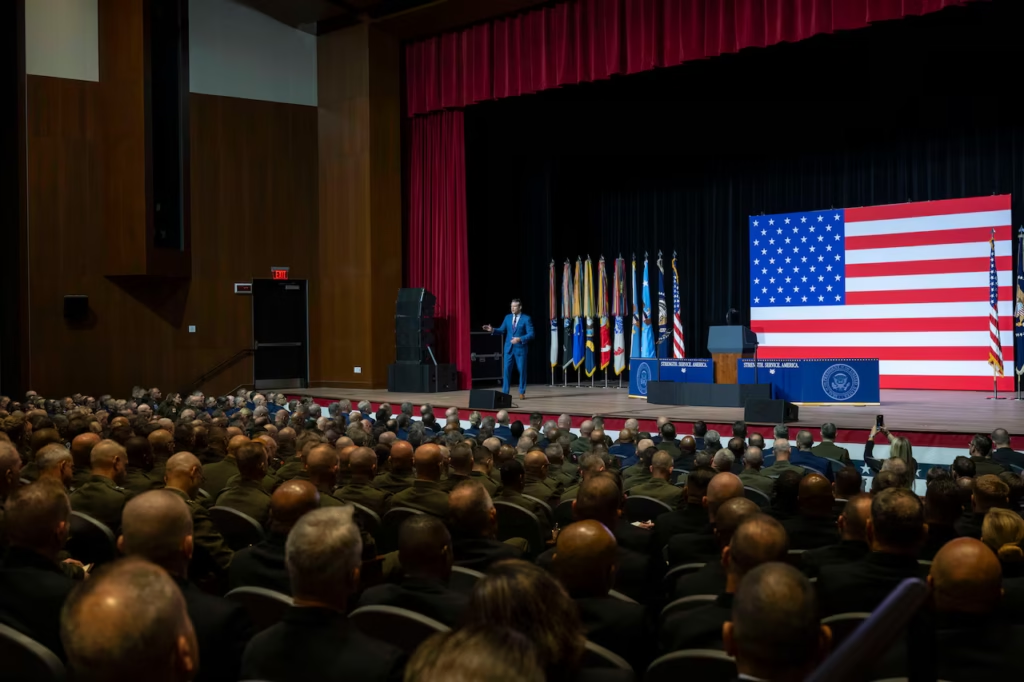“We should use some of these dangerous cities as training grounds for our military, National Guard,” …President Donald Trump
President Donald Trump addressed senior military leaders on September 29, 2025, at the Marine Corps Base Quantico, urging the use of “dangerous” U.S. cities as “training grounds” for the military and National Guard. He specifically named Chicago, New York, Los Angeles, San Francisco, Portland, and Washington, D.C., framing the initiative as necessary to confront what he termed a “war from within.” Trump asserted that real-world urban environments would better prepare troops for modern operations than traditional training centers.
Trump’s remarks come amid recent deployments of National Guard forces to cities such as Portland, Washington, D.C., and Memphis for public safety missions. He instructed generals to “handle” domestic unrest, equating internal disorder with foreign threats. “We should use some of these dangerous cities as training grounds for our military, National Guard,” he said, promising deployments to Chicago “very soon.”
Historical Urban Training Grounds and Legal Boundaries
Although the military has long prepared for urban operations at purpose-built sites, live exercises in populated areas have been exceedingly rare. The most notable precedent was Operation Urban Warrior in 1999, when Marines conducted drills at the abandoned Oak Knoll Naval Hospital and Naval Air Station Alameda in California. That exercise unfolded in deserted complexes to avoid civilian harm and backlash, yet still drew protests likening the maneuvers to an occupation.
The Posse Comitatus Act of 1878 generally bars federal troops from domestic law enforcement, with exceptions under the Insurrection Act. Legal experts warn that using active-duty forces for training missions amid civilian populations would blur the line between preparation and enforcement, risking violations of constitutional safeguards and state sovereignty.

Historical Comparisons Highlight Risks
This proposal echoes past abuses of military power, from Reconstruction-era troop deployments enforcing racial segregation to Cold War era “Jade Helm” drills that fueled conspiracy fears. Like a hammer turned inward, the plan transforms America’s metropolises into proving grounds for force—a metaphorical crucible where civil liberties and military readiness collide.
In contrast, today’s urban warfare doctrine emphasizes Military Operations on Urban Terrain (MOUT) facilities such as Indiana’s Muscatatuck Urban Training Center and Guam’s Skaggs Complex. These controlled environments feature mock cityscapes and role-players, insulating civilians from live drills and preserving legal boundaries.
Implications for Civil-Military Relations
Critics argue that the Trump Training Grounds concept risks normalizing a perpetual military footprint in domestic life and undermining trust in uniformed services as apolitical guardians. Supporters counter that immersive urban experience is essential given the growing complexity of global conflicts centered in cities.
As lawsuits mount—Oregon’s challenge to Portland deployments being one example—this proposal may find itself at the center of a legal tug-of-war over federal authority and civil rights. Whether American cities will become battleground classrooms or remain off-limits to live-fire drills will test the resilience of constitutional norms. As lawsuits mount—Oregon’s challenge to Portland deployments being one example—this proposal may find itself at the center of a legal tug-of-war over federal authority and civil rights. Whether American cities will become battleground classrooms or remain off-limits to live-fire drills will test the resilience of constitutional norms.
President Donald Trump addressed senior military leaders on September 29, 2025, at the Marine Corps Base Quantico, urging the use of “dangerous” U.S. cities as “training grounds” for the military and National Guard. He specifically named Chicago, New York, Los Angeles, San Francisco, Portland, and Washington, D.C., framing the initiative as necessary to confront what he termed a “war from within.” Trump asserted that real-world urban environments would better prepare troops for modern operations than traditional training centers.




